Uniformitarianism and Catastrophism
Uniformitarianism is the assumption that the same natural laws and processes that operate in the universe now have always operated in the universe in the past and apply everywhere in the universe. Geologically speaking, uniformitariansm can be summed up in the phrase: "the present is the key to the past." The processes that we see at work at the earth's surface today are the same ones that have acted there in the past. Thus, we can use our observations of present-day processes to interpret rock record of past events.
This is valuable in a number of ways. We can better predict the distribution of important geological resources such as oil, coal, building stone. We can better predict the location of geological hazards. We can also better understand the nature of past environments and ecosystems.
However, our knowledge of the present is, geologically speaking, a snapshot in time. We have a very poor knowledge of long-term trends as we have only been collecting data for a few centuries to millenia, depending on the nature of the data. We also have very little knowledge of rare events from our the perspective of our observations of the present such as: massive volcanic events (on the scale of millions of cubic kilometres of material), large asteroid impacts, major changes to oceanic circulation patterns, and magnetic field reversals. Catastrophism, in its modern sense, is the understanding that major upheavals to the day-to-day life of the earth do occur from time to time. The earth also experiences significant long-term trends (millenia and longer) in climate and other systems (such as global warming). Our present-day observations have little experience with these. Our best understanding of these comes from an examination of the abundant evidence of them in the rock record, especially the sedimentary rock record. We can see how often they occur, what the short-term and long-term effects were, and start to plan for how to either prevent or moderate them or at least survive from them and re-adapt. We can also better plan how much of our resources to set aside for dealing with them.
Sedimentary Rocks
Sedimentary rocks are formed from pre-existing rocks or pieces of once-living organisms. 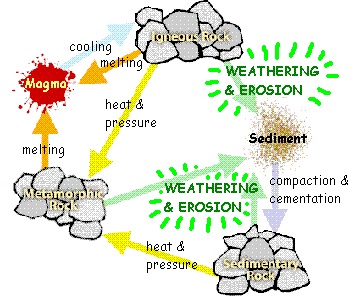
They form from deposits of particles that accumulate on the Earth's surface: sediment.
The source of sediment is the weathering (physical and chemical breakdown) of pre-existing rock.
Sediment usually is transported from where it is generated by weathering to a basin or depression where it is deposited (erosion).
Lithification is the process of joining the sediment particles together to form a new rock. This may involve compression of the grains to reduce void space and causing grains to become interlocked as well as the precipitation of chemical compounds that cement grains together. Compression of sediment into rock usually requires deep burial under younger sediment.
Common Sedimentary Rocks:
Common sedimentary rocks include sandstone, limestone, and shale.
These rocks start as sediment and dissolved minerals which are carried in rivers (as well as air currents, glaciers, ocean currents) and deposited into lakes and oceans.
Clastic Sedimentary Rocks:
Clastic sedimentary rocks are the group of rocks most people think of when they think of sedimentary rocks. Clastic sedimentary rocks are made up of pieces (clasts) of pre-existing rocks and mineral grains. There are two processes necessary for the formation of sediment: weathering and erosion.
Biologic Sedimentary Rocks:
Organisms create skeletons from ions (metals, carbonate, phosphate, and silicate) that they remove from sea water or from theier food. Biologic sedimentary rocks form when large numbers of living things die, pile up, and are compressed and cemented to form rock. Accumulated carbon-rich plant material may form coal. Deposits made mostly of animal shells form limestone, chalk, coquina (all calcium carbonate), and chert (silica).
Chemical Sedimentary Rocks:
Chemical sedimentary rocks are formed by chemical precipitation. The stalactites and stalagmites you see in caves form this way, so does the rock salt that table salt comes from. This process begins when water traveling through rock dissolves some of the minerals, carrying them away from their source. Eventually these minerals can be redeposited - precipitated - when the water evaporates away, when the water becomes over-saturated with respect to these minerals (due to mixing of different water masses of by changes in temperature), or indirectly by biological activity.
Production of Sediment
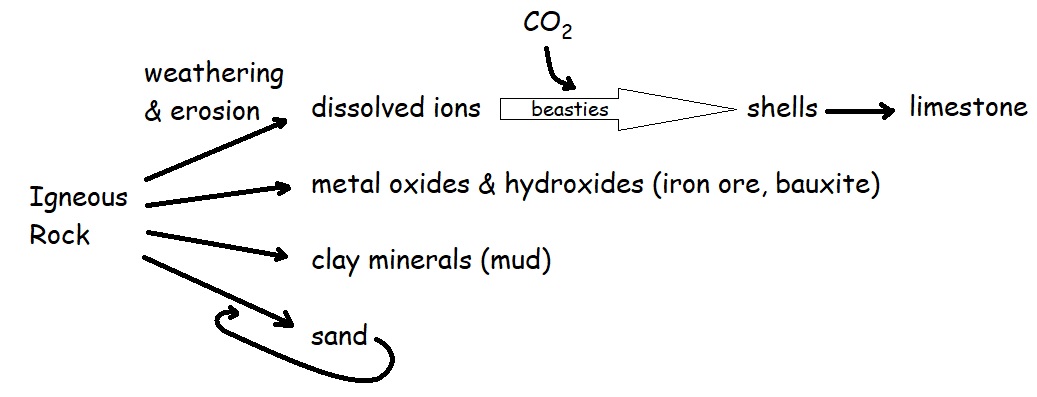
1) Weathering is the process of physically and chemically breaking down a rock into sediment. Physical weathering can take the form of water freezing in cracks to fragment a rock, animal and plant activity, and any thing else that causes a rock to break apart. Chemical weathering includes chemical reactions between rock minerals and organic acids in rain and ground water, dissolving of water soluble minerals, oxidation of mineral, and many complex chemical reactions involving plants, animals, and bacteria. Both types of weathering work together: chemical weathering weakens the rock, physical weathering opens up cracks to increase the surface area for chemical reactions.
Weathering can be as simple as turning large masses of rock into small grains of sand in which the material is not much different from the original rock. On the other hand, it can be as complex as turning crystals of feldspar into entierly new minerals such as clay.
Mechanical weathering is the physical process that breaks down rock without altering its chemical composition.
Abrasion is an example of mechanical weathering. This occurs during collisions with other objects. Frost wedging is another example of mechanical weathering. This occurs when water seeps into the cracks of rocks and freezes. As water freezes, it expands. This expansion places pressure on the surrounding rock and causes the rock to crack or split. Canadians are all too familiar with this process, as evident from the number of potholes that cover our roads and highways. Biological processes also contribute to mechanical weathering. The roots of plants may eventually grow into the cracks of rock. The process is similar to frost wedging as the roots place pressure on the surrounding rock, forcing it to break apart. Click here to view examples of mechanical weathering.
Chemical weathering involves the breakdown of rock by altering its chemical composition.
Hydrolysis is an example of chemical weathering. This occurs when the hydrogen molecules of water react with minerals in rocks. View hydrolysis in action as feldspar breaks down to form clay minerals. This process demonstrates all of the posible results of weathering: new minerals are formed (clays from feldspars), the weaker clay minerals allow the other mineral grains (quartz, for example) to disaggregate into small grains, and many of the ions are dissolved and washed away in the process of transforming the feldspar into clay.
Carbonation is another example of chemical weathering. Rainwater contains carbonic acid, which reacts with minerals in rocks causing the rock to break down.
Oxidation is another common form of chemical weathering. Oxidation weakens the rock as oxygen reacts with minerals such as olivine and pyroxene, turning them into more iron oxides (eg., limonite) and other minerals more stable at the earth's surface.
The production of dissolved material (metal, silica, carbonate, and sulfate ions, etc.) is just as important as the production of small grains of solid material. These ions eventually get precipitated as chemical and biological sediment and sedimentary rock.
2) Erosion is the process of removing sediment particles from a rock surface and carrying them away to another location. This can occur through wind action, water, landslides, and animal activity. Erosion is a necessary for continued weathering. If weathered material is not removed, a rock will eventually be covered by a crust of weathered material and will be too isolated from the environment for further weathering to take place.
Once pieces of rock are loosened by weathering, they are transported to some basin or depression where sediment is trapped. If the sediment is buried deeply, it becomes compacted and cemented, forming sedimentary rock. Clastic sedimentary rocks may have particles ranging in size from microscopic clay to huge boulders. Their names are based on their clast or grain size. The smallest grains are called clay, then silt, then sand. Grains larger that 2 millimeters are called pebbles. Shale is a rock made mostly of clay, siltstone is made up of silt-sized grains, sandstone is made of sand-sized clasts, and conglomerate is made of pebbles surrounded by a matrix of sand or mud.
Generally, the larger the clasts (particles of sediment) present in a rock, the more powerful were the wind or water currents that carried the sediment. For example, a fast moving mountain stream will deposit coarse gravel but carry away mud and fine sand to some place further down stream. That same river, closer to its mouth where it is moving more slowly will have deposited its coarse sediment up stream and the water will only be carrying fine mud particles to deposit onto the river bed.
Erosion also includes the movement of dissoled ions.
Clastic Sedimentary Rock
These are sedimentary rocks made from rock and mineral fragments that have been cememted together to form a solid mass.
Sedimentary rocks can be described and classified by a number of different properties:
1a) Composition.
Most clastic sedimentary rocks are composed of minerals that are stable at the earth's surface.
Mudstones and shales are made mostly of clay minerals. These are similar to micas, but with more hydroxyl groups (-OH) bonded to the silica and alumina tetrahedra. These minerals are the byproduct of weathering of micas, feldspars, and other silicate minerals.
Sandstones are mostly made of quartz grains, but some contain grains of muscovite and potassium feldspar if the sediment has not been intensely weathered. They also contain cement minerals (see below).
Conglomerates, rocks with very large sediment particles, often contain a wider variety of minerals as the larger fragments are not completely weathered (and take longer to chemically decompose into more stable minerals).

1b) Cement.
Aqueous silica solubility increases with pressure. Thus, silica dissolves away where grains are pressing together and reprecipitates in the pore spaces between the grains where pressure is lower. Thus, sand grains can cement themselves together as they are buried and compressed by overlying material. However, movement of fluids through the sediment can cause precipitation of other cements such as calcium carbonate and iron oxide. The type of cement often says a lot about the environment in which the sediment was accumulated and the conditions under which is was lithified.
1c) Accessory Minerals.
While the minerals in 1a make up most clastic sedimentary rocks, there are usually other minerals present in small amounts, particularly minerals such as zircon, garnet, magnetite, and corrundum. These are physically resistant and fairly stable at the earth's surface, but not abundant components of igneous or metamorphic rock. They are, however, often diagnostic of certain types of metamorphic and igneous rocks, which makes them useful at tracking the original source of sediment grains (provenance). This can tell one a lot about the geography of past environments (where the mountains were, the path of river systems: features that are important, but often not preserved in the rock record because they represent features dominated by erosion rather than deposition of sediment).
2) Grain Size.
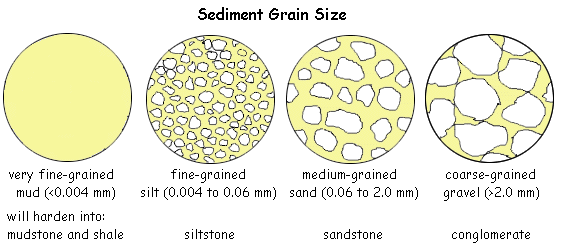 Physical weathering tends to reduce the size of sediment grains. So, sediment grains come in a wide continuum of sizes, from boulders and gravel, through sand and silt, to mud in which the grains are too small to be seen without magnification. However, the most stable common mineral is quartz, and Bowen's reaction series results in quartz grains growing into the last of the pore spaces present in intrusive volcanic rocks. Thus, one of the most abundant types of clastic sediment is sand-sized quartz grains. Physical weathering tends to reduce the size of sediment grains. So, sediment grains come in a wide continuum of sizes, from boulders and gravel, through sand and silt, to mud in which the grains are too small to be seen without magnification. However, the most stable common mineral is quartz, and Bowen's reaction series results in quartz grains growing into the last of the pore spaces present in intrusive volcanic rocks. Thus, one of the most abundant types of clastic sediment is sand-sized quartz grains.
The largest grain size that can be carried by a moving fluid depends on the density of the fluid as well as (in air and liquids) the speed at which the fluid is flowing. Generally, the faster the rate of flow, the larger the maximum grain size that can be moved. This is because the settling speed of sediment grains increases as the grains get larger.
Bigger grains = faster current. |
 3) Sediment Sorting. 3) Sediment Sorting.
As the speed of a moving fluid, such as the water in a river, slows down, the larger sediment grains can no longer be moved and are deposited. If the river slows down very rapidly or if the sediment is moved only a short distance, then a wide range of grain sizes will be deposited in the same place and a poorly sorted sediment results. If the sediment is transported over great distances and the water speed slows very gradually then only a narrow range of grain sizes will be deposited in any one place and a well sorted sediment will result.
Sorted sediment = gradual decrease in water current speed downstream over long periods of time.
Graded sediment = gradual increase or decrease in water current speed over a short time in one place. |
4) Rounding.
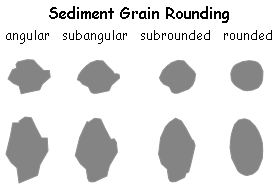 The more a sediment grain is transported the more it tends to get physically weathered. One of the effects of this is to remove all of the sharp corners and edges on the grain - it becomes more rounded. Usually, significant rounding requires many cycles of erosion and deposition. The more a sediment grain is transported the more it tends to get physically weathered. One of the effects of this is to remove all of the sharp corners and edges on the grain - it becomes more rounded. Usually, significant rounding requires many cycles of erosion and deposition.
More smooth and more rounded = longer period of erosion (transport of grains) and maybe more cycles (erosion -> deposition)
|
Summary
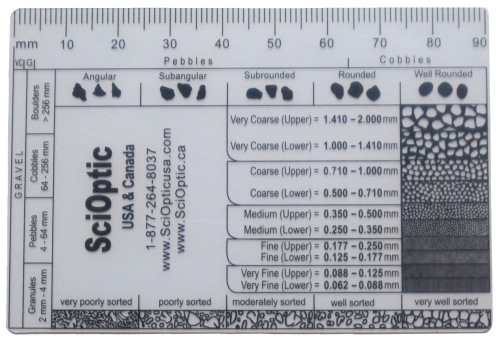 Generally, the farther that a sediment has been carried from where it was eroded and the longer it has been moved around, and the more times it is weathered and eroded, the better sorted, more rounded, and more chemically uniform the particles will be. Thus, sediment at the foot of a mountain will be poorly sorted and the particles will have lots of rough edges. That same sediment after rivers have carried it to the ocean will be more rounded and each range of particle sizes will have been deposited in a different location along the river as the river current slows down, and most of the less stable minerals will have been chemically weathered away. Generally, the farther that a sediment has been carried from where it was eroded and the longer it has been moved around, and the more times it is weathered and eroded, the better sorted, more rounded, and more chemically uniform the particles will be. Thus, sediment at the foot of a mountain will be poorly sorted and the particles will have lots of rough edges. That same sediment after rivers have carried it to the ocean will be more rounded and each range of particle sizes will have been deposited in a different location along the river as the river current slows down, and most of the less stable minerals will have been chemically weathered away.
Geologists often take cards such as the one of the right in order to more quickly and precisely judge these properties in sedimentary rocks.
|
5) Porosity and Permeability.
Porosity refers to the proportion of rock volume made up of void space between the mineral grains. This property controls how much fluid (water, gas, oil) can be stored in a sedimentary rock. Permeability is a measure of how well interconnected these pore spaces are. Without some permeability, fluids can not enter or pass through a rock. The better the permeability, the more easily valuable fluids, such as gas and oil, can be extracted.
The better a sediment is sorted, the greater the porosity and permeability tend to be.
|
6) Bedding.
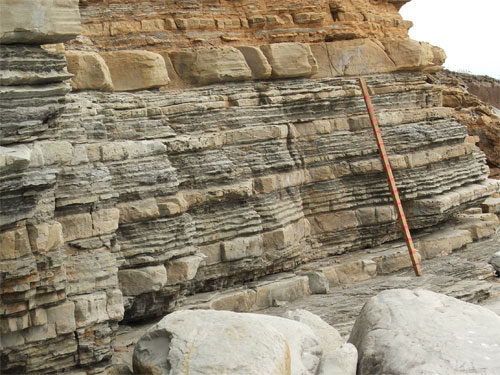 Rock beds usually represent an event of some sort.
Rock beds usually represent an event of some sort.
These can be short and energetic (as for some sandstones) or long periods of quiet settling of materials (as for most mudstones and shales).
If the rocks are layered:
- How thick are the layers?
- How are the layers of different rock types arranged (alternating, clustered together)?
- Are there any patterns or trends in the layering that you can identify (do the proportions of rock types change vertically)?
- Are the upper and lower surfaces of each layer flat, undulating, irregular?
- Do the layers stay roughly the same thickness along their exposure?
- Are the boundaries between layers sharp or do they grade into one another?
Bed Thickness
Thicker beds result from both faster deposition of material and longer periods of deposition. Fine-grained muds generally accumulate slower than sand, so a 10 cm thick bed of mudstone or shale would represent a much longer period of time than a 10 cm thick bed of sandstone.
|
7) Sedimentary Structures.
Sedimentary structures (cross bedding within a bed and features on either the upper or lower surface) can give valuable clues as to the type of processes and environment that produced the rock layer.

Most of these will be features created by physical processes (wind and water currents, mostly).

Unidirectional flow (eg rivers) vs bidirectional flow (caused by waves in shallow water).

Wind-blown (aeolian) sand often produces cross-bedding on a massive scale.
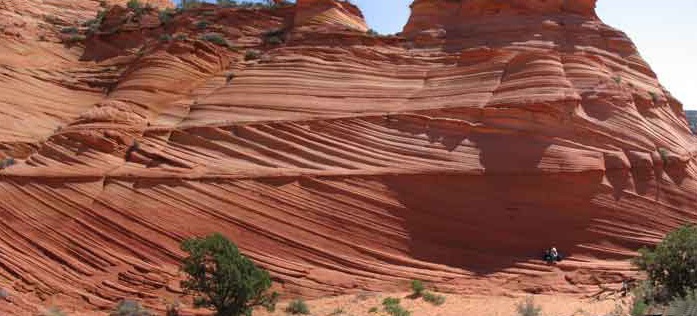
Some sedimentary structures are made by the activities of organisms (including fossil burrows and tracks) as well as their physical remains. These provide a wide variety of messages about the environmental conditions at the time of deposition. Trace fossils (fossil tracks and burrows) are particularly useful as, unlike skeletal remaims, they cannot be moved after they are made. Thus, they tell us what conditions were like right where they are found.

Body fossils (physical remains) are much less common in sandstones as the fluids that move through the sediment pore spaces tend to dissolve the minerals that would make up the fossils.
Features on the upper and lower surfaces of the rock layers include mud cracks (indicative of drying out of a pond or river) and scrapes and other "tool" marks left on the ground as objects bounced or dragged along by wind and water currents. These get preserved with the same currents deposit sand onto these marks.
Ripple marks also can be left on the upper surface of a sand layer once sand deposition begings to wane.
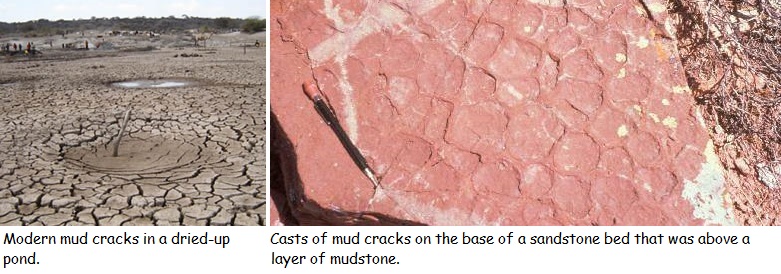
Useful Wikipedia summaries:
* sedimentary structures
* ripple marks
Examples
thin, flat layers = weak to no water current
thin, flat layers in sand with aligned grain orientation = extremely fast current
asymmetrical ripples and cross bedding = moderate current
symmetrical ripples = alternating current direction (shallow water waves, beach backwash)
tool marks = sudden strong current
trace fossils = conditions conducive to life
aeolian dunes = wind; not under water
mud cracks = periodic drying up of rivers and lakes
|
8) Environment of Deposition.
This is a more interpretive classification. None of the features described above are diagnostic of any particular environment, though many are characteristic of different environments. What defines different depositional environments are not so much certain sedimentary features, but rather assemblages of features: patterns of different features horizontally and vertically in successive rock layers. There are a wide variety of depositional environments on the earth's surface. Each has its characteristic assemblages of sedimentary rock (both clastic as well as biological and chemical).
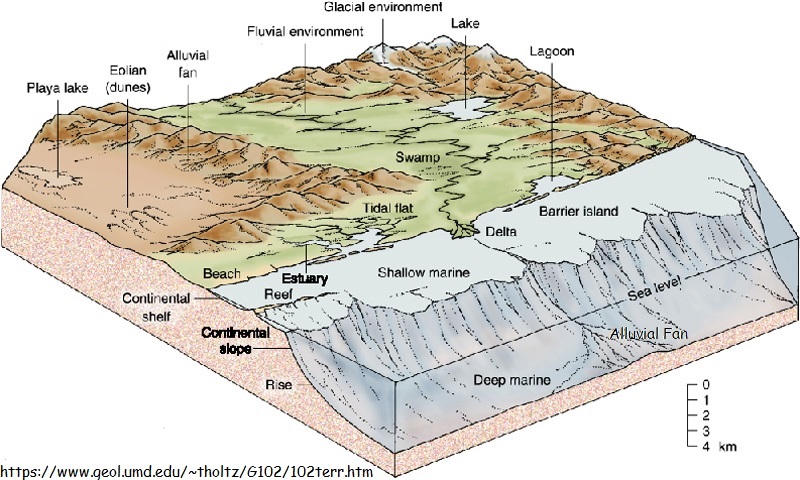
8a) Fluvial (river systems): braided rivers.
Minute Earth video on meandering rivers.
Minute Earth video on river deltas.
Video on types of rivers.
The lateral shifting of the river channel and the "point bar" of sediment deposited on the inside of each meander curve leaves a characteristic latteral pattern of cross=laminated sandstones. There will also be channel-shaped deposits of sandstone where channels are abandoned and filled in. These deposits will transition laterally and vertically into muddier sediments of the flood plane interspersed with sandstone layers from flooding events.
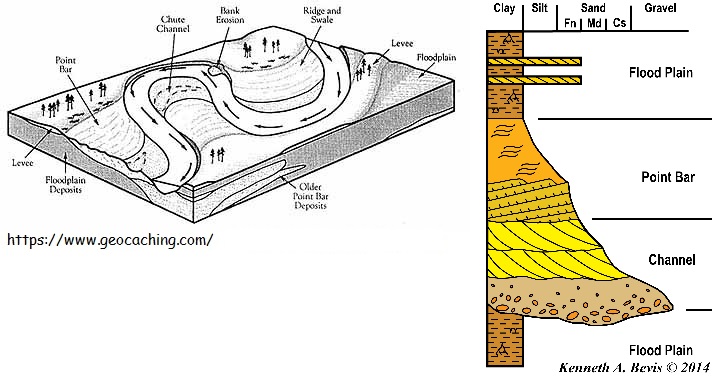
8b) Alluvial Fans: turbidite deposits.
Video on turbidites
These features are formed by undersea landslides down the continental slope at the edge of continents, usually associated with river deltas, which spread out onto the deep ocean plane. Turbidites have a typical vertical assemblages of sedimentary structures indicative of a sudden, very swift sediment-laden current that becomes slower and less sediment-laden over time. Repeated events can produce very thick sequences of these stratigraphic assemblages.
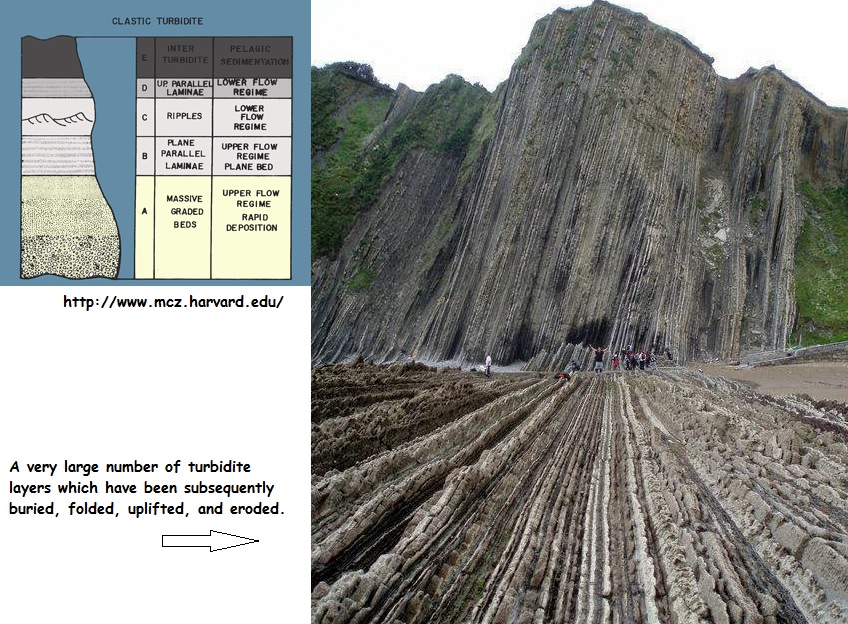
|



 Physical weathering tends to reduce the size of sediment grains. So, sediment grains come in a wide continuum of sizes, from boulders and gravel, through sand and silt, to mud in which the grains are too small to be seen without magnification. However, the most stable common mineral is quartz, and Bowen's reaction series results in quartz grains growing into the last of the pore spaces present in intrusive volcanic rocks. Thus, one of the most abundant types of clastic sediment is sand-sized quartz grains.
Physical weathering tends to reduce the size of sediment grains. So, sediment grains come in a wide continuum of sizes, from boulders and gravel, through sand and silt, to mud in which the grains are too small to be seen without magnification. However, the most stable common mineral is quartz, and Bowen's reaction series results in quartz grains growing into the last of the pore spaces present in intrusive volcanic rocks. Thus, one of the most abundant types of clastic sediment is sand-sized quartz grains. 3) Sediment Sorting.
3) Sediment Sorting. The more a sediment grain is transported the more it tends to get physically weathered. One of the effects of this is to remove all of the sharp corners and edges on the grain - it becomes more rounded. Usually, significant rounding requires many cycles of erosion and deposition.
The more a sediment grain is transported the more it tends to get physically weathered. One of the effects of this is to remove all of the sharp corners and edges on the grain - it becomes more rounded. Usually, significant rounding requires many cycles of erosion and deposition. Generally, the farther that a sediment has been carried from where it was eroded and the longer it has been moved around, and the more times it is weathered and eroded, the better sorted, more rounded, and more chemically uniform the particles will be. Thus, sediment at the foot of a mountain will be poorly sorted and the particles will have lots of rough edges. That same sediment after rivers have carried it to the ocean will be more rounded and each range of particle sizes will have been deposited in a different location along the river as the river current slows down, and most of the less stable minerals will have been chemically weathered away.
Generally, the farther that a sediment has been carried from where it was eroded and the longer it has been moved around, and the more times it is weathered and eroded, the better sorted, more rounded, and more chemically uniform the particles will be. Thus, sediment at the foot of a mountain will be poorly sorted and the particles will have lots of rough edges. That same sediment after rivers have carried it to the ocean will be more rounded and each range of particle sizes will have been deposited in a different location along the river as the river current slows down, and most of the less stable minerals will have been chemically weathered away. Rock beds usually represent an event of some sort.
Rock beds usually represent an event of some sort. 







